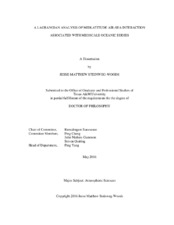| dc.description.abstract | Oceanic eddies, approximately 80 km in diameter in the mid-latitude Atlantic Ocean, are frequently generated along the Gulf Stream. These eddies contain a sea surface temperature anomaly as they spin and break away from the main current. Oceanic eddies have been shown to effect the lower atmosphere in several regions in prior studies, influencing rainfall rates, cloud cover, and surface wind speeds in satellite observations. Eddy features are located using an automated detection algorithm and the atmosphere surrounding each eddy's location is studied. Coupled global and regional models, utilizing both atmospheric and oceanic components, are tested to investigate their capability of demonstrating the atmospheric response compared to observations.
It is found that the atmospheric influence of oceanic eddies is primarily limited to the boundary layer, with an exception for vertical motion influence that can extend beyond it. Eddies with a positive sea surface temperature anomaly core increase the formation of low-level clouds and rainfall slightly downstream of the eddy center, with clouds forming consistently at a height of approximately 850 hPa in models and reanalysis data. The vertical mixing mechanism is shown to be the cause of the wind response to oceanic eddy influence. This is based on a dipolar pattern of wind divergence aligning with the sea surface temperature gradient, along with a change in horizontal wind speed close to the top of the boundary layer due to vertical momentum transfer.
The results show coupled models overestimate the coupling strength between sea surface temperatures and the atmospheric response compared to observations. This indicates coupled models are capable of adequately simulating the atmospheric response, as long as the oceanic component's resolution is eddy resolving. In the regional model, parameterized convection showed a very similar result to explicitly resolving the convection. Therefore, the atmospheric response to oceanic eddies can be simulated properly even if the convection has been parameterized. | en |


